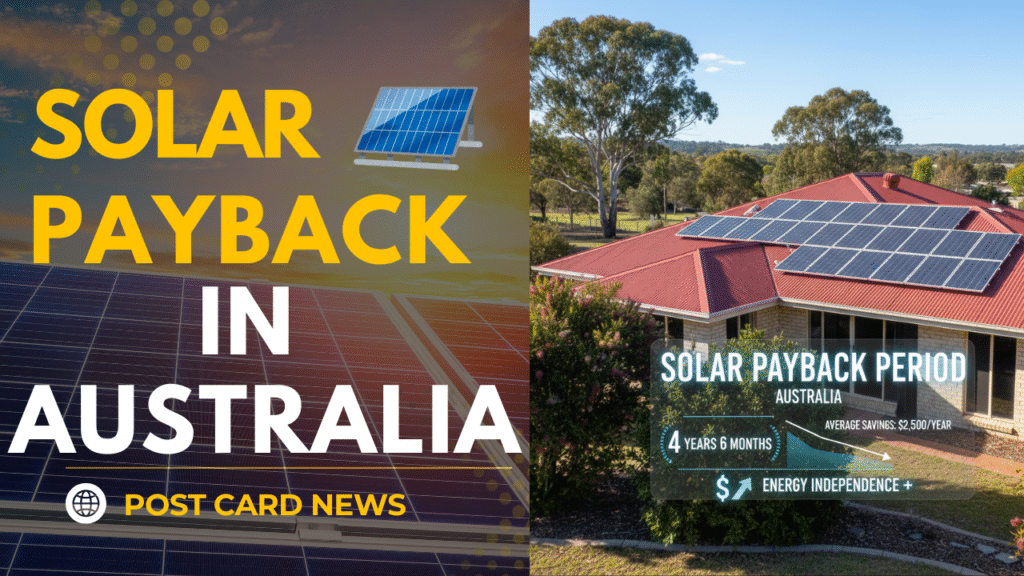The solar payback period in Australia is shorter than many think, with new research showing homes can recoup costs in under five years on average. As electricity bills climb, more Aussies are installing panels and batteries to cut expenses – but how long until savings kick in? iSelect’s Solar Payback Report crunched the numbers for capital cities, factoring in system size, usage, and rebates. For a standard 6.6kW setup, the solar payback period in Australia averages 4 years 10 months without a battery, stretching to 9 years with one. Perth leads the pack at 3 years 8 months, while Darwin tops long-term savings at $1,919 a year. Upfront costs average $6,246 for solar or $17,473 with battery (after rebates), but federal and state incentives make it easier. Here’s a straightforward guide to what it means for your wallet.

What Makes the Solar Payback Period in Australia So Quick?
The solar payback period in Australia is the time it takes for energy savings to match your install cost. iSelect analyzed a 6.6kW system for mid-users (7kW/day), including rebates like the federal Small-scale Renewable Energy Scheme. High sun exposure, feed-in tariffs (money for excess power), and rising bills (up 15% yearly) speed things up. Without battery, it’s 4 years 10 months average. Batteries add storage but extend to 9 years – still worth it for blackout-prone areas. System costs: $6,246 solar-only, $11,227 battery extra. Usage matters: High users (10kW/day) shave 1–2 years off.
Solar Payback Period in Australia: City Breakdown Without Battery
For mid-range homes, here’s the solar payback period in Australia by capital:
| City | Payback Time (Years/Months) |
|---|---|
| Sydney | 4 years, 2 months |
| Melbourne | 5 years, 6 months |
| Brisbane | 4 years, 11 months |
| Adelaide | 3 years, 9 months |
| Perth | 3 years, 8 months |
| Hobart | 6 years, 7 months |
| Darwin | 5 years, 2 months |
| Canberra | 4 years, 9 months |
Perth’s edge: Cheap setups ($5,800 average) and strong tariffs (10c/kWh).
Solar Payback Period in Australia: With Battery Added
Batteries (12kWh average) store power for evenings or outages, but raise costs:
| City | Payback Time (Years/Months) |
|---|---|
| Sydney | 6 years, 11 months |
| Melbourne | 10 years, 10 months |
| Brisbane | 7 years, 8 months |
| Adelaide | 6 years, 2 months |
| Perth | 7 years, 0 months |
| Hobart | 13 years, 0 months |
| Darwin | 8 years, 9 months |
| Canberra | 8 years, 11 months |
Adelaide shines with state rebates, cutting payback by 1 year.
Yearly Savings After the Solar Payback Period in Australia
Post-payback, the solar payback period in Australia turns profitable. Darwin leads without battery at $1,919/year for mid users, Sydney $1,326, Melbourne $888, Brisbane $1,245.
With battery: Darwin $2,376, Sydney $2,288, Melbourne $1,439, Brisbane $2,201. High users in Adelaide save $3,019/year – covering a family grocery bill.
Ways to Shorten Your Solar Payback Period in Australia
Julia Paszka from iSelect says match your system to needs: Too big wastes money; too small limits savings. Review bills for daily use (5–10kW typical). Rebates slash costs:
- Federal: Small-scale certificates for upfront cuts.
- Victoria: $1,400 Solar Homes.
- ACT: Home Energy Support.
- Adelaide/WA: Local incentives.
Batteries get 30% federal discount + state extras. Compare 3 quotes, install off-peak, bundle for deals. Clean Energy Council-approved pros ensure quality.
Common FAQs
A: 4 years 10 months without battery, 9 years with – Perth fastest at 3 years 8 months for mid users.
A: $1,300–$3,000, depending on city/usage – Darwin $1,919 without, Adelaide $3,019 with for high users.
A: Federal Small-scale scheme + state like Victoria’s $1,400 – total 20-40% off, cutting 1–2 years.
A: Yes – mid (7kW/day) 4-5 years; high (10kW) 3-4 years in sunny cities.
A: For outages/high use, yes – saves $2,000+ yearly after 6-9 years, with 30% rebates.

